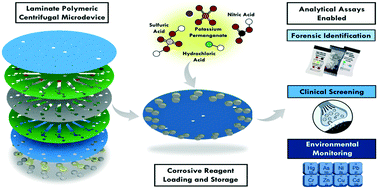Dielectric heating of highly corrosive and oxidizing reagents on a hybrid glass microfiber–polymer centrifugal microfluidic device†
Abstract
Many assays necessitate the use of highly concentrated acids, powerful oxidizing agents, or a combination of the two. Although microfluidic devices offer vast potential for rapid analytical interrogation at the point-of-need (PON), they cannot escape the fundamental requirement for reagent compatibility. Worse, many innovative protocols have been developed that would represent a significant improvement to current field-forward practices within their respective disciplines, but adoption falters due to chemical incompatibility with challenging reagents. Polymeric centrifugal microfluidic devices meet many of the needs for accommodating complex chemical or biochemical protocols in a multiplexed and automatable format. Yet, they also struggle to accommodate highly reactive chemical components long term. In this work, we report on a simple and inexpensive reagent storage strategy that bypasses the typical complexity involved with integration of liquid reagents on microfluidic devices. Moreover, we demonstrate microdevice compatibility and operation after six months of corrosive reagent storage as well as post dielectric heating. This new strategy allows for storage of multiple highly corrosive and oxidative reagents simultaneously, enhancing the possibilities for multistep assay integration at the PON for a diverse array of applications. Successful detection after one week of corrosive reagent storage of an illicit drug and neurotransmitter metabolite, for forensic and clinical applications, is demonstrated. Furthermore, environmental sample preparation via microwave-assisted wet acid digestion is performed on-disc and integrated with downstream detection. Quantitative detection of a heavy metal in soil is achieved by way of on-disc calibration and found to be accurate within 2.4% compared to a gold standard reference (ICP-OES).



 Please wait while we load your content...
Please wait while we load your content...